
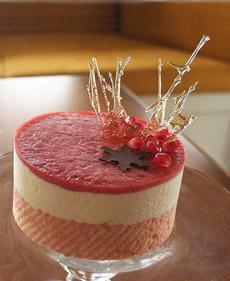
An eggnog mousse cake on a dacquoise base. Photo by Allie Cooper | Wikimedia Commons.
June 2009
Last Updated September 2025
|
 |
Pastry Glossary: Different Pastry Types
Flan & Other Types Of Pastry & Pies
Page 4: Definitions With D To F
This page contains terms such as flaky pastry, flan, and French pastry. This is Page 4 of a ten-page glossary. Click the black link below to visit other pages. See our many other food glossaries, each featuring a different favorite food.
DACQUOISE
A dacquoise (dah-KWAHZ) is a meringue-based dessert. It can be either a layered dessert of meringue (usually with chopped almonds or hazelnuts), alternating with a chocolate or mocha mousse, buttercream, or whipped cream; or it can be a meringue cup filled with mousse, custard, or whipped cream and garnished with fruit. It takes its name from the feminine form of the French word dacquois, meaning “of Dax,” a town in southwestern France. See photo above; the base is a layer of dacquoise. See also marjolaine.
|
DANISH PASTRY or DANISH
A variety of rich, buttery breakfast pastries made from a slightly sweetened yeast dough that is rolled out, dotted with butter, then folded and rolled several times in the manner of puff pastry (see laminated pastry). The dough may be flavored with vanilla or cardamom. Danish pastries are made in a variety of shapes with different fillings, including sweetened cream cheese, cooked fruit (apple, apricot, cherry, and prune are popular), poppy seed, almond paste, and nuts.
|
|
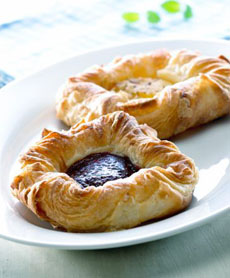
One style of Danish pastry. Photo © Yuri Arcurs | Dreamstime. |
DARIOLE
A puff pastry baked in a dariole mold (slightly taller and narrower than a ramekin) and then filled with almond cream, custard, or other filling (there are savory darioles as well). Cream horns are a variety of dariole; the molds are also used to make egg custards, puddings, timbales, and individual rhum babas.
DEEP DISH PIE
A sweet or savory pie made either in a deep pie dish, which has only a top crust. A deep dish pie pan will be 1-3/4 or 2 inches deep, as compared with 1 inch for a regular pie pan.
DESPERATION PIE
A group of pies, also called “make-do” pies, from the Great Depression, that were made from common, inexpensive pantry ingredients that cash-strapped households could afford (fresh fruit, for example, was out of the question financially unless it was in season). Desperation pies showcased the ingenuity and resilience of home cooks who found ways to create desserts and maintain some normalcy during the hardest economic times. Examples include buttermilk pie, chess pie, shoofly pie, vinegar pie, and even water pie.
|
DEVONSHIRE CREAM PIE
Two circles of plain pastry filled with cream pie filling and topped with a ring of pastry. The pie is garnished with fresh strawberries or other fruit plus whipped cream. The fruit can be glazed with melted currant jelly.
DIPLOMAT
A Parisian breakfast pastry: flaky croissant pastry filled with custard and raisins. Photo at right.
DOUGH
Dough is made from flour, fat, salt, and water: The fat (butter, margarine, olive oil, or suet, e.g.), flour, and salt are combined, water is added, and the paste is rolled into dough.
|
|
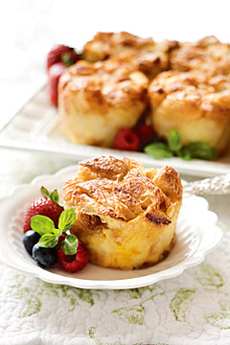
Diplomats are available at MackenzieLtd.com. |
|
DOUGHNUT or DONUT
A doughnut is a small, fried ring of sweet, leavened dough. Doughnuts leavened with baking powder are denser than the fluffier, yeast-leavened doughnuts. Originally a Dutch recipe without a hole, the dough is dropped into hot oil, and was originally called an olykoek, or oily cake. The first written reference to “doughnut” is in Washington Irving’s 1809 History of New York, where he writes of “balls of sweetened dough, fried in hog’s fat, and called doughnuts, or olykoeks.”
|
|
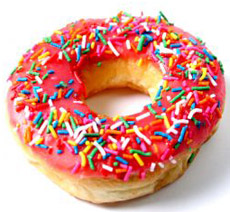
A frosted doughnut with sprinkles. Photo by Michael Lorenzo | SXC. |
It is said that in 1847, 16-year-old Hanson Gregory created the hole in the center of the doughnut by using the top of a round tin pepper container to punch the holes, so the dough would cook evenly. There are many types of doughnuts. Just a few include bismarks or jelly doughnuts, raised doughnuts leavened with yeast, squares and twists, crullers made from twisted cake-doughnut dough, and French doughnuts made with cream-puff pastry dough. They can be filled or unfilled, plain, glazed, or iced.
There are also savory doughnuts. Check out these Garlic Parmesan Doughnuts.
|
DUMPLING
There are different types of dumplings, but they all involve a piece of dough. Sweet dumplings are dough wrapped around fruit, baked, and served as a dessert, such as apple dumpling (here’s the recipe for the dumplings in the photo). Savory dumplings are sometimes filled with meat or vegetables, and can be cooked in liquid such as water or soup, and served in soup. Others are served as a side starch, instead of potatoes. Some people refer to fried balls of sweet or savory dough as dumplings.
|
|
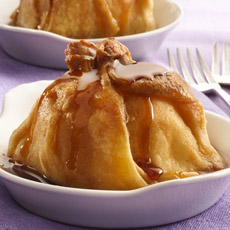
Apple dumplings. Photo courtesy Betty Crocker. |
|
ÉCLAIR
An elongated, finger-shaped pastry made of pâte à choux (puff pastry), filled with whipped cream or custard and topped with ganache or a glacé icing (glaze). The éclair is known to have originated in France around the turn of the 19th century. Many food historians speculate that éclairs were first made by Marie-Antoine Carême (1874-1833), the first “celebrity chef,” considered the founder and architect of French haute cuisine: cookbook author, and chef to Talleyrand, the future George IV of England, Emperor Alexander I of Russia, and Baron James de Rothschild.
|
|

Éclairs (photo © Lady M Cakes). |
The Oxford English Dictionary traces the word “éclair” in the English language to 1861. The first known recipe for éclairs appears in the 1884 edition of the Boston Cooking-School Cook Book, edited by Mrs. D.A. Lincoln (and later by Fanny Farmer). “Éclair” is the French word for lightning. It is suggested that the pastry received its name because it glistens when coated with confectioner’s glaze. We would suggest that it is because they are so popular that they disappear as quickly as lightning. See also cream puff.
|
ELEPHANT EAR COOKIE
See palmier.
EN CROÛTE
En croûte (French for “in crust”) refers to a food that is wrapped in pastry and baked. Meats, fruits, vegetables and cheeses are prepared en croûte. Foods with the exception of cheeses, which have long cooking times, are usually cooked partially prior to wrapping so the crust doesn’t overcook.
ENTREMET
The French word for mousse cake, a light confection that typically has a base of cake, a mousse layer, a thin layer of pastry cream layer and a topping of fruit coulis. See photo at the top of the page.
FILO PASTRY
An alternative spelling for phyllo pastry.
|
|
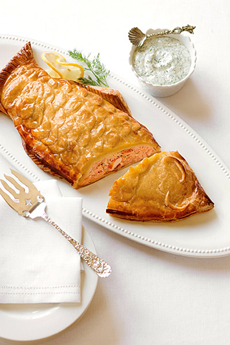
Salmon en Croûte available from MackenzieLtd.com. |
FLAKY
A pie crust with a dry texture that easily breaks off into flat, flakelike pieces.
|
FLAKY PASTRY or ROUGH PUFF
PASTRY
A crisp, buttery pastry that is a simpler, more quickly prepared version of puff pastry. Flaky pastry expands when cooked due to the number of layers. The “puff” is obtained by beginning the baking process at a high temperature and then lowering it. See pastry.
FLAMBÉ
French for “flamed” or “flaming,” a dramatic method of presenting foods aflame. This is done by warming liquor, such as brandy, igniting it, and pouring it over the dessert immediately prior to serving. The fire goes out when the flames consume the alcohol. Steamed puddings (especially Christmas Pudding) and Crêpes Suzette are two popular desserts to flambé.
|
|
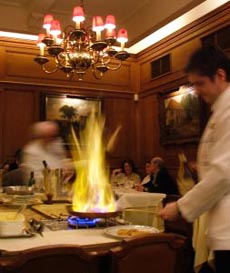
Flambé. Photo by Paul Kemp | SXC. |
|
FLAN
In the pastry world, there are two definitions for flan. (1) A single-crust (open) pie with a sweet or savory custard filling. Spinach flan or leek and bacon flan are examples of savory flans. (2) A single-crust pie filled with pastry cream (crème pâtissière) and topped with fruit. Both examples are baked in a fluted flan ring, a short pan (about 11/2-inch-high) with a removable bottom. (3) Outside of the pastry world, flan, known as creme caramel in Spain, where it originated, is a baked custard topped with a layer of caramel that is baked on the bottom but becomes the top when the custard is inverted onto the plate.
The Modern English word flan and the earlier flawn come from the French word flan. Tracing backwards, the Old French flaon derived from Medieval Latin fladonem, which itself derived from the Old High German flado, a flat ceremonial cake. So, today’s flat tart flan is the historical descendant of the old German flado.
|
|

Flan parisien, or flan pâtissier, is a staple of French pastry. Here’s the recipe (photo © La Cuisine de Geraldine). |
FLAUGNARDE
A flaugnarde is a clafoutis (cherry flan) made with a fruit other than cherries: apples, peaches, pears, plums, and prunes, for example. Also spelled flagnarde, flognarde, and flougnarde, it is a baked flan with pockets of fruit. It can be made in a ceramic dish, like a custard, or in a tart pan with a crust.
FLORENTINE MERINGUE PIE
Puff pastry covered with tart jam and topped with meringue. The meringue is sprinkled with chopped toasted almonds and dusted with powdered sugar.
FRANGIPANE or FRANGIPANI
As with flan, above, there are two or more interpretations for frangipane. Originally, frangipani was a custard tart flavored with almonds or pistachios. (1) It came later to mean an almond cream (crème pâtissière flavored with finely ground almonds or macaroons) or custard used as filling in pastries and cakes (if crème pâtissière, it can also be used as a topping). (2) Frangipane is a type of Belgian almond pastry tart made with pâté a choux. Usually, the tarts have a striped icing pattern on top, similar to a hot cross bun from above.
FRANGIPAN CREAM PIE
A pie filled with vanilla pudding, into which macaroon crumbs and lemon flavoring (zest or extract) have been added.
FRENCH PASTRY
A style of rich, elaborately constructed and decorated pastries based on puff pastry, prepared in individual portions with rich fillings such as crème pâtissière, custard, and fruit.
FRENCH SILK PIE
See silk pie.
FRITTER
Food that has been dipped in batter and deep-fried or sautéed. They can be savory like corn fritters or sweet like apple fritters.
Continue The Next Page: Terms With G To L
Return To The Article Index Above

|












